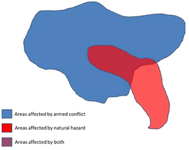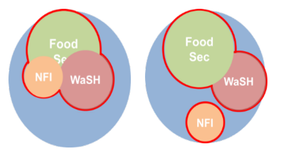...
The single most important challenge is to avoid double counting when aggregating across multidimensional (i.e. sectors, type of event) and hierarchical (administrative divisions 1, 2 and 3) categories since one particular individual can belong to several categories at the same time. For instance, one individual can be in need in the shelter AND the health sector and will appear in both sectors’ PIN estimates. This calls for specific disambiguation methods when aggregating figures available at geographical and sector level.
| Field Example: Multiplicity of crisis and geographical overlap- Colombia Humanitarian Crisis 2015 | |
|---|---|
In the 2015 Humanitarian Needs Overview for Colombia, the population in need was estimated by including people affected by both the armed conflict AND by recurrent natural disasters. The number of people in need due to the armed conflict in 2015 was calculated considering population affected by the armed conflict and armed violence between 2012 and 2014. The number of people in need as a result of natural disasters is an estimate of people living in areas affected both by natural disasters and armed conflict leading to situations of compounded vulnerability. Since the geographical area where both events have happened is the same, using the sum of both populations in need would lead to double counting. | |
...
This approach is best used in a context where estimates are available at low administrative levels or affected groups, so aggregation can be performed using as many mutually exclusive categories as possible, even crudely.
| Field Example: When using multidimensional data, use the Max value to avoid double counting | |
|---|---|
| For example, if the total population in a given district is 15,000 and there are 15,000 people in need of food assistance, 10,000 in need of WASH and 5,000 in need of NFI, it is obvious that the total number of people in need (15,000+10,000+5,000=30,000) would be greater than the actual population (See figure 13: “actual” number of people with humanitarian needs corresponds to the areas delimited by the red lines.) Given that people with needs in food security may also have needs in WASH and nutrition, an overlap of figures is extremely likely. However, the strength of correlations between needs would have to be known at the individual level in order to count populations with distinct sectoral needs, so it is difficult to ascertain exact figures without a household level representative survey. |
...

